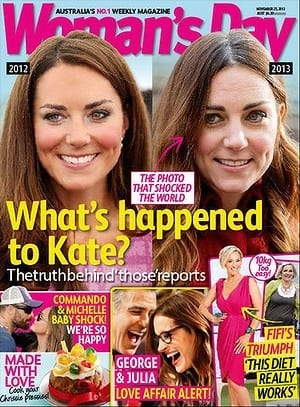What’s happened to Kate Middleton? This is the question that is posed on the cover of a weekly magazine that is currently sitting on the newsstands. Two pictures of the Duchess of Cambridge accompany the headline. In one photo, from 2012, Middleton’s hair colour is uniform but in the second image, dubbed ‘the photo that shocked the world’, from 2013, she has grey roots showing through. Hence, the cover’s important inquiry. So what happened?
The major event that took place in the intervening period between the two photos is that Middleton gave birth to her first child but I am quite certain everyone at the magazine knows that. The obvious, quite practical, answer to the question posed is that Middleton let her roots show through. Again, however, I get the sense the people at the magazine didn’t need the assistance of its readers, or me, to point that out.
Of course the real question they are asking is this: what was Middleton thinking in leaving the house — or the Palace as it most likely is in her case — without having her grey roots covered? Is this the beginning of the end for the princess? Is she, gasp, letting herself go? Has she had a baby and decided that it’s acceptable to be seen in public looking less than perfect?
Whether it was inadvertent and she didn’t realise her roots were showing, or, she knew and brushed it aside, personally I think it’s terrific. (And not just because I also have dark hair with more greys than someone in their early 30s might want.) I think it’s terrific because the message in either of those scenarios is this: that her appearance isn’t the single most important thing about her.
A few weeks ago in her acclaimed Andrew Olle lecture Lisa Wilkinson touched on the invidiousness of the post-baby-body post-mortem that mothers in the public eye are routinely subject to. She said “I despair whenever I hear the words “Post Baby Body” accompanied by images of yet another celebrity who in four amazing weeks has managed to immediately wipe away any physical trace of evidence that she had ever been pregnant in the first place. And we’re meant to aspire to that?”
The way a woman looks is still often considered more important than what she does. It’s evident, as Wilkinson highlighted, in the scrutiny women on television face. Their outfits, their hair and their make-up generates more interest and feedback than anything they say.
These days the disproportionate focus on a female’s physical appearance is never more apparent – or more undesirable – than after having a baby. The notion that eliminating any physical sign of pregnancy the minute a baby is brought into the world is a laudable accomplishment is absurd. And yet it’s where we are at. Bearing a child is a rather physical experience and it takes a physical toll. Expecting anything different is madness.
The way a woman feels about her appearance after giving birth is dependent upon many things, mostly her own self-esteem. But it is undeniable that women who give birth today will feel some pressure to look the way they did before they had a baby and quite quickly. It’s another dimension of the disparity between what we expect motherhood to be like and what motherhood is like and it can be unsettling.
The Duchess of Cambridge is one of the most-photographed women in the world and her appearance is consequently subject to extraordinary public scrutiny. In light of that her decision to let her grey roots show through is refreshing. It indicates she’s comfortable with not looking perfect which is a welcome attitude. It’s not one we see that often.
The truth is Middleton is no better or no worse for having grey hairs, in the same way that a mother is no better or worse if she’s five kilograms heavier after giving birth. A person’s physical appearance is just one aspect of who they are; it is not the defining quality. And when you are in the throes of looking after a new baby it is often, and understandably, a lower priority.
If you see a copy of the offending magazine please feel free to print this out and stick it over the cover. Personally I think the cover is more ‘shocking’ than the image it bears. Particularly given it was published to coincide with postnatal depression awareness week. What do you think?


